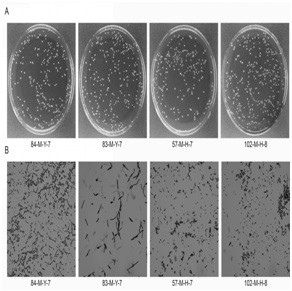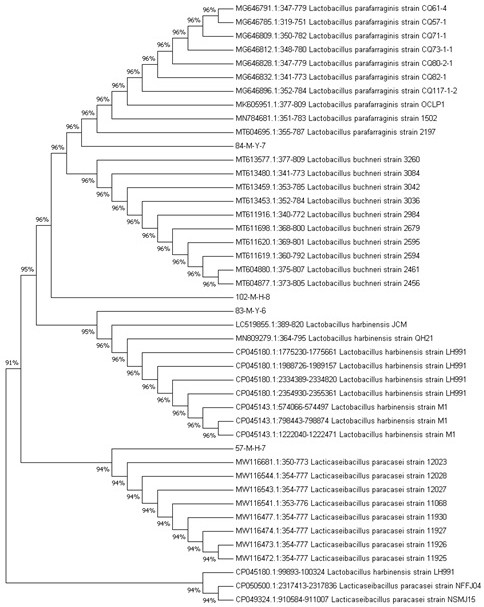Lactobacillus cavings for fermentation and application thereof
A technology of Lactobacillus glutinum and Lactobacillus, applied in microbial technology and its application fields, can solve the problems of no fermented products, and achieve the effects of promoting release, improving taste, and good fermentation characteristics
- Summary
- Abstract
- Description
- Claims
- Application Information
AI Technical Summary
Problems solved by technology
Method used
Image
Examples
Embodiment 1
[0033] Embodiment 1 Isolation and purification of lactic acid bacteria
[0034]The collected folk enzyme products were diluted 10-fold with sterile saline in a clean bench, and 1 mL of the bacterial solution with an appropriate dilution was taken and evenly spread on the lactic acid bacteria identification medium with a coating stick and placed at 37 °C Cultivate in an anaerobic incubator at constant temperature for 48-72 h. Then take out the culture based on picking a single colony with a diameter of 1-2 mm and a smooth surface in a sterile environment, and inoculate it on a new lactic acid bacteria identification medium by the method of streaking, and repeat it several times until the pure colony is isolated and purified. At this time, the bacteria were initially identified as lactic acid bacteria, and the strains were numbered. The screened lactic acid bacteria were serially diluted with sterile saline, and the colony morphological characteristics and micromorphological ch...
Embodiment 2
[0036] Embodiment 2 Lactobacillus strain identification
[0037] The phenotypic characteristics and 16S rDNA of the purified strains were systematically identified.
[0038] 1. Phenotypic characteristics and phenotype observation:
[0039] The morphological characteristics of the isolated 4 strains of lactic acid bacteria were as follows: figure 1 shown by figure 1 It can be seen from A that the colony shape of the strains is milky white, the edges are relatively regular and round, the surface is smooth, and the diameter of the colonies is in the range of 1.0-1.5 mm. They are named 84-M-Y-7, 83-M-Y-6, and 57 respectively. -M-H-7 and 102-M-H-8. The 4 strains of lactic acid bacteria were identified by Gram staining, and the characteristics of the bacteria were observed under a 100 times oil lens. The results of microscopic examination showed that all the strains were Gram-positive strains, and the bacteria were rod-shaped and arranged in various ways.
[0040] 2. 16S rDNA...
Embodiment 3
[0043] Embodiment 3 Lactobacillus furfur ( L. farraginis ) 84-M-Y-7 Screening
[0044] Select fresh dendrobium, remove sundries and rotten leaves, wash the dendrobium with flowing water, cut into sections (about 2-3 cm), blanching (about 10-20 s), squeeze the juice, and boil (about 10-20 s), filled into a 250 mL Erlenmeyer flask. A 250mL Erlenmeyer flask was sterilized at 121°C for 15 minutes.
[0045] Inoculate the activated 4 strains of lactic acid bacteria into the pre-sterilized MRS liquid medium in the ultra-clean workbench for 3-4 subcultures. When the number of viable bacteria reaches 1×10 7 When the CFU / mL is above, the seed liquid is prepared for use.
[0046] The seed solutions of 4 lactic acid bacteria were inoculated into Dendrobium juice according to the inoculum amount of 10% for fermentation. The fermentation conditions were: 37 ℃ constant temperature static culture for 48 h, and then transferred to 4 ℃ low-temperature refrigerator for post-ripening for 48 h...
PUM
 Login to view more
Login to view more Abstract
Description
Claims
Application Information
 Login to view more
Login to view more - R&D Engineer
- R&D Manager
- IP Professional
- Industry Leading Data Capabilities
- Powerful AI technology
- Patent DNA Extraction
Browse by: Latest US Patents, China's latest patents, Technical Efficacy Thesaurus, Application Domain, Technology Topic.
© 2024 PatSnap. All rights reserved.Legal|Privacy policy|Modern Slavery Act Transparency Statement|Sitemap



